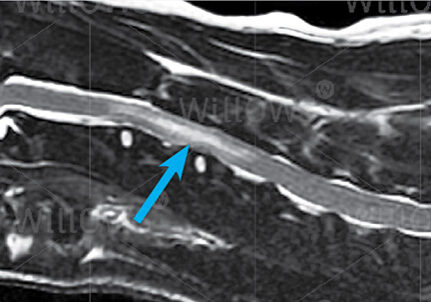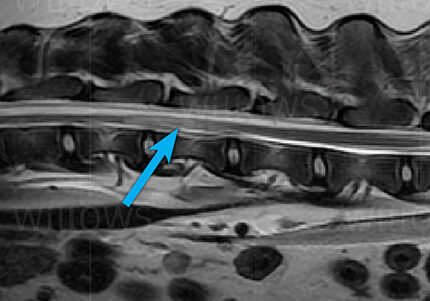Why should I bring my pet to Willows for treatment of an ischaemic myelopathy?
Willows is one of Europe’s leading small animal referral centres. Our state-of-the-art hospital is led by internationally renowned Specialists, committed to providing the highest standards of veterinary care. Our Specialist Neurosurgeons are supported by our multi-disciplinary team of Specialists across a number of different disciplines including; Anaesthesia, Diagnostic Imaging and Emergency and Critical Care.
Willows has a large dedicated team of Vets, Nurses and clinical support staff available 24 hours a day, every day of the year to provide the best possible care for your pet. This combination of exceptional facilities and expertise allows Willows to provide the most accurate diagnosis and optimal care for any patient with epilepsy.
What is an Ischaemic Myelopathy?
Ischaemic myelopathy is a condition where the blood supply to part of the spinal cord (the bundle of nerves that run inside the spine) is suddenly interrupted by a ‘clot’ that blocks a small artery (blood vessel). This is similar to a stroke or heart attack in people, except that it is the spinal cord that is affected rather than the brain or heart.
What causes an Ischaemic Myelopathy?
‘Ischaemia’ is a loss of blood supply, and ‘myelopathy’ is a form of damage to the nerves of the spinal cord. The cause of the blockage of the spinal cord blood vessels is poorly understood. In the majority of cases the ‘clot’ which blocks the artery is similar in structure to the material that forms the discs (the cushions between the bones of the spine). This disc material is called ‘fibro-cartilage’. It is assumed that some of this disc material somehow moves from its normal location to become lodged in the blood vessels of the spinal cord. This is the reason why the condition is commonly referred to as ‘fibrocartilaginous embolism’ (shortened to ‘FCE’).

What are the Signs of an Ischaemic Myelopathy?
Ischaemic myelopathy most commonly occurs in large breed dogs, although it is also encountered in smaller breeds and, very occasionally, in cats. The onset of neurological signs is always extremely rapid and can occur during exercise. Neurological abnormalities may vary from mild weakness or incoordination, through to an inability to walk. Paralysis, incontinence and inability to feel pain are possible in severe cases. Ischaemic myelopathy is a non-painful condition, although at the initial onset some patients may cry out or yelp. Neurological signs do not tend to progress after the first 24 hours.
Fig 1: MRI scan showing an ischaemic myelopathy (FCE) in the neck (arrow)


How is an Ischaemic Myelopathy Diagnosed?
Ischaemic myelopathy is diagnosed by ruling out other causes of sudden onset neurological signs, such as a ‘slipped disc’ (see information sheets on cervical disc disease and thoracolumbar disc disease), traumatic disc extrusion or a spinal fracture.
Advanced diagnostic imaging investigations are necessary in order to diagnose ischaemic myelopathy and to rule out other conditions, an MRI scan is the imaging technique of choice in these circumstances. MRI scanning uses high powered magnets and a computer to generate images of the spine. It provides detailed information on the location and extent of any blood vessel-related injury to the spinal cord.
Fig 2: MRI scan showing an ischaemic myelopathy (FCE) in the back (arrow)
How is an Ischaemic Myelopathy Treated?
There is no specific treatment for ischaemic myelopathy. Supportive care and nursing are essential in order to aid recovery. Bedding needs to be well padded in order to prevent bed sores. Regular physiotherapy and in some cases, hydrotherapy can help function to be regained and assist in building strength. Some patients may require a catheter to be placed in the bladder temporarily to aid urination.
What is the Outcome for Patients with Ischaemic Myelopathy?
The outcome in dogs with ischaemic myelopathy depends on two key factors: the location and the severity of the spinal cord injury. The findings on the neurological examination and MRI investigations can help to predict the chances of recovery. Dogs that are paralysed and cannot feel pain in their limbs are unfortunately unlikely to recover. The majority of less severely affected dogs will gradually improve over a period of weeks to months, to a point where they can freely exercise and have a good quality of life. A degree of weakness in one or more limbs may persist in some dogs. Recurrence of ischaemic myelopathy is very uncommon.
To save this page as a PDF, click the button and make sure “Save as PDF” is selected.
Neurology
Find out more
To assist owners in understanding more about Neurological conditions, investigations and treatment we have put together a range of information sheets to talk you through the some of the more common neurological conditions seen by our Specialists.

